#gastropod detected
Explore tagged Tumblr posts
Note
That purple pikmin seems like an exceptionally attractive woman. I bet she's a joy to be around and very beautiful. I bet she's got a huge brain
Interesting that you knew the pikmin was purple when the drawing was in greyscale...
12 notes
·
View notes
Text
Round 1 - Phylum Mollusca
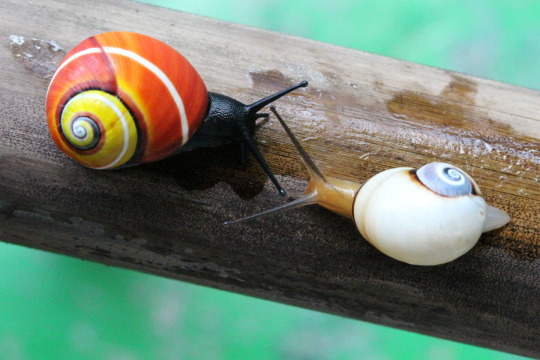
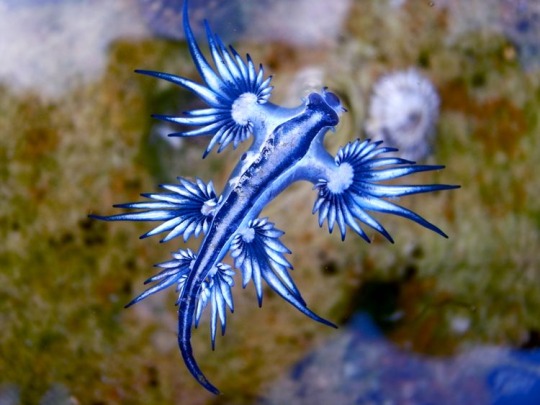
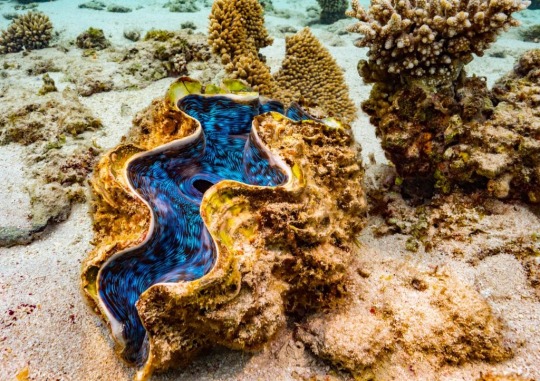
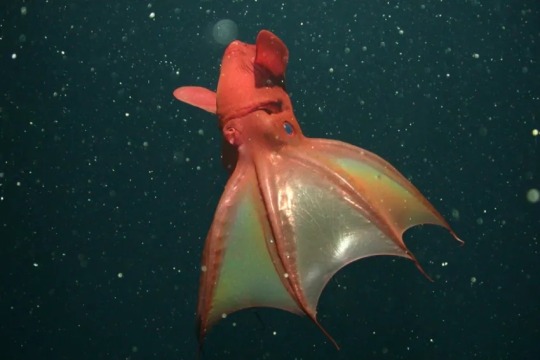
(Sources - 1, 2, 3, 4)
The second largest phylum, Mollusca contains over 76,000 living species and somewhere between 60,000 and 100,000 extinct species, including the ammonites and helcionelloids. Living groups include the chitons, solenogasters, caudofoveates, cephalopods (octopuses, squids, cuttlefish, nautiloids, etc.), scaphopods, gastropods (slugs and snails), and bivalves.
Molluscs are highly diverse, living on land, in freshwater, and in saltwater, where they comprise over 23% of all named marine organisms. The most diverse molluscs are the gastropods which comprise over 80% of known molluscs. Due to their high diversity, the only things most molluscs have in common are a soft body composed almost entirely of muscle, a mantle with a significant cavity used for breathing and excretion, the presence of a radula (bivalves excluded), and the structure of their nervous system.
Many molluscs are endangered due to collecting and killing individuals for their meat and/or decorative shells.

Propaganda under the cut:
Cephalopods are one of the (if not the) most neurologically advanced of all invertebrates and are capable of using tools, solving puzzles, and play.
Masters of camouflage, many cephalopods can change color, shape, and texture to hide from predators, sneak up on prey, and communicate with each other
The largest molluscs are the Giant Squid (Architeuthis dux), with 12–13 m (39–43 ft) long females and 10 m (33 ft) long males, and the Colossal Squid (Mesonychoteuthis hamiltoni) which is estimated between 10 m (33 ft) and 14 m (46 ft) long. The Giant Squid has much longer tentacles, but the Colossal Squid is heavier, reaching a mass of at least 495 kilograms (1,091 lb). The largest specimens of Colossal Squid, known only from beaks found in sperm whale stomachs, may perhaps weigh as much as 600–700 kg (1,300–1,500 lb).
Mollusc shells make up most of the “seashells” washed ashore, and are created by the animal via secretions of chitin and conchiolin from its mantle edge. Not all molluscs have shells (ex: nudibranchs) and for some, the shell is internal (ex: cuttlefish). Mollusc shells come in many beautiful colors, shapes, and sizes.
Most molluscs have eyes, and all have sensors to detect chemicals, vibrations, and touch. Of the phyla we have covered so far, their senses are the most developed.
Conchs can look at you like this:
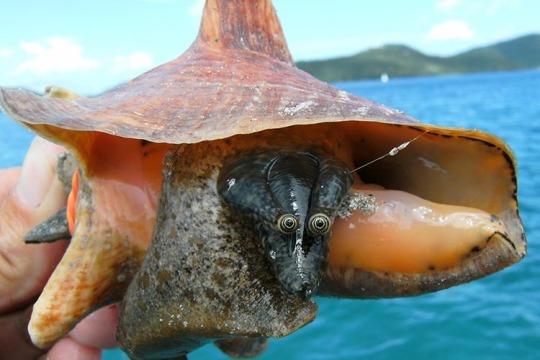
(Source)
All cone snails are venomous, and some of the larger species are some of the most venomous animals in the world. Even though some species’ stings are fatal to humans, their sophisticated venom has saved lives through its use in neurological research.
Humans don’t just use mollusk meat and shells, but also luxuries like pearls, mother of pearl, Tyrian purple dye, and sea silk. As stated above, many species are now endangered due to human use, but some are farmed for their meat, pearls, and shells. The farming of bivalves is more ecologically-friendly than the farming of chordates as, rather than create waste, bivalves like mussels and oysters actually clean the water.
As filter-feeders, bivalves are natural water filters. A single 5.08 cm (2 inch) clam can filter up to 10-12 gallons of seawater a day. They can even filter microplastics out of polluted water.
The largest bivalve is the Giant Clam (Tridacna gigas) which can weigh over 200 kilograms (440 lb), measure as much as 120 cm (3.11 ft) across, and have an average lifespan in the wild of more than 100 years.
Cover your ears, kids. Terrestrial slugs, which are hermaphroditic, have some of the most intimate sex on the planet. A pair of slugs will suspend from a chord of mucus, heads down, and intertwine their bodies in a tight spiral. They will then evert their penuses and entwine them as well, exchanging sperm while hanging in midair. Slug porn, narrated by Sir David Attenborough, for your viewing pleasure.
#round 1#animal polls#we’ve reached my first personal favorite because cuttlefish are genuinely one of my all time favorite animals#mollusca
197 notes
·
View notes
Note
Hi.
I got bitten by a snail today.
I don't know how much you know about behaviours of snails and such creatures but it's probably more than me. This is not really an ask, I just wanna share this anegdote.
So I was on my way back home and it's raining a lot here these days. I live in a southern part of Eastern Europe. Due to the rain there are snails popping out left and right. I saw what I believe was an adult one on my path and I wanted to move it to some grass so that noone steps on it or runs it over with a bike (I see the results of that pretty often -_-). I decided that I'm gonna direct it with my hand instead of picking it up, since I had time to spare. It went well for about 5 minutes until the snail gave up and decided to move straight into my finger and bite me. I think it was trying to bite me since I know how their mouth parts function, and I could feel it's little saw-like teeth barely grinding against my skin.
Are snails(and similar fellows) usually this brave or did it just stop seeing my hand as an obstacle? I don't really know how much they think. I remember playing with snails in the rain in my childhood but I don't think one ever bit me.
if you aren’t approaching or attacking the snail, it probably won’t register you as a threat. given that slugs and snails have a very good sense of taste, it likely detected minerals or protein and decided it was worth getting them from your flesh! I’ve been nibbled on by various gastropods before for the same reasons.
169 notes
·
View notes
Text
Slimy Hivemind? Breaking Locks In The Digital Age!
Lana found a dark room full of shattered glass and smashed consoles. The shadows were deep and long even though the door was broken, barely hanging on to battered, squeaking hinges as light streamed in from the corridor. Lana made herself at home, crosslegged in the shade behind the wreckage. She set the transponder snail gently in her lap, ignoring the sounds of the lab's occupants as they sporadically rushed past her little hideout, shouting about a trail of destruction, rampaging children and escapees.
"Calm-calm library feng-sui," Lana muttered, enveloping herself in a bubble of silence. The usefulness of the tactic was two-fold: it would help her avoid detection from outside and enable her to focus on the task at hand. "Now, little snail..."
The small creature trembled in her lap, unhappy to have been taken from its post. Lana turned it to face her and placed her hands on either side of its shell.
"Don't be scared," she crooned, instinctively reassuring the animal before reach out to it using her haki. "I won't hurt you... I just want to see if you can help me find my friends."
The premise of her idea was simple enough. If she could sense emotions, interpret thoughts from what an individual was feeling, she saw no reason why she wouldn't be able to extend that empathy to the transponder snail. She closed her eyes, narrowed her focus and pushed her perception entirely into the slimy hivemind nestled helplessly in her lap.
Immediately, she was met with resistance.
"Guess this little guy's operating on an encrypted channel," she surmised.
Even so, she could feel the differing wavelengths intuitively, could discern the distinct signals bouncing between the snails in the lab.
"What do you want from me, a passkey?" she mused, brow knitting over closed eyes as she rubbed her thumbs absently over the spiral patterns of the snail's shell.
That was it, she could tell. Lana grinned, pursuing strands of information, bullying her will through the mental noise of the transponder snails and demanding that they yield to her influence.
"Just like a physical lock, the tumblers hold all the answers," she reasoned aloud. The snail's eyes were completely glazed over by now, drifting aimlessly back and forth on their stalks as Lana rummaged through its tiny, simple mind like a thief going through a drawer. "I can figure this out... it's just another puzzle, just another lock waiting for me to open it."
Lana's grin widened in the darkness. She executed the psychic equivalent of a knuckle crack, leading the snail in her lap to shiver a little inside its shell.
___________________________________
Zoro was sweating with exertion by the time he managed to push his perception out by ten yards in all directions.
'I wonder if I could get better range by narrowing the radius.'
He envisioned a strip of haki sweeping out from his person. The next image that came to mind was a radar scope, one thin line swinging around in a circle as it searched for its target. Zoro liked the idea a lot, but before he could try to put it into practice, a shiver swept down his spine and a strong, familiar presence seized his full attention.
"Lana?!"
He could feel her in the room with him, but when he opened his eyes, she was nowhere to be seen. Even so, her aura was suddenly overwhelming, undeniably present. It felt as though she was hanging over his head like a specter.
Zoro glanced up to make sure she really wasn't hovering over his shoulder. The only thing he saw was a video transponder snail in the corner over the desk. He narrowed his eyes, suspicions mounting as he stared down the gawking gastropod. The force of Lana's haki wasn't fading and it seemed to be concentrated around the snail.
"Lana?" he questioned tentatively. He didn't hear a response, but something in his gut urged him to get closer to the transponder snail. He followed his instincts, nudging the desk over a few inches and hopping up onto its surface to put himself on eye level with the snail. Its eyestalks tipped forward, seeming to reach for him sluggishly. The display was puzzling and mildly repulsive.
'Is this snail... trying to touch me?' he wondered, fascination pairing with mystification as he leaned in closer. He reached up and pulled the snail from the ceiling. It made a gooey sucking noise as it released its hold and allowed him to carry it back down to the couch.
As soon as he made contact with the snail, Zoro felt Lana's presence more strongly than ever before. His first thought was that the snail was Lana. Somehow, Lana had been turned into a snail.
'That's stupid,' he scolded himself internally. 'Lana didn't get transformed into a snail. There's something else going on here.'
Zoro reached for the presence of Lana's haki with his own. If he didn't know better...
'This snail feels like it's... pulling me?'
He surrendered to the tug, allowing his perception to essentially be hijacked. The shift was disorienting and he had to blink a few times to interpret the image he was seeing.
"Lana?"
Her face was gray and wreathed in static as if he was seeing her through a screen of some kind. Transponder snail eyes, he realized with a jolt.
Lana grinned down at him and waved intentionally. Her mouth moved, but he couldn't hear the words.
"I can't hear you," he grumbled aloud. Could she see him too? He tapped his ear and made a slicing motion at his throat.
Lana nodded and raised two fingers to her eyes.
"I. See. You," she mouthed slowly, pointing to the snail. Zoro understood.
"Where are you?" he asked aloud. He gestured around him and then raised his hands in a questioning shrug, palms facing up.
"No idea," Lana shook her head, shrugging back. "The others?"
She steepled her hands over her head, miming a hat. Zoro chuckled a little. A straw hat. She was asking after their crewmates.
"Everyone's fine," he assured her, flashing a thumbs up. "Look. I'm here."
He turned his transponder snail around, showing her the room where he was.
"Come. Find. Me," he told her, gesturing from her to him and making a little walking gesture with his fingers.
Lana facepalmed.
"I was just there," she sighed. Zoro raised an eyebrow to let her know he didn't understand what she'd said. She shook her head dismissively. "It's not important. I'll... uh... oh crap."
Zoro watched as Lana trailed off and her gaze grew distant.
Zoro could only see Lana, but Lana was watching the equivalent of a split-screen feed from snails posted all over the island. A battle outside few her attention.
"Luffy's fighting someone," she noted.
"I don't understand," Zoro said emphatically, shrugging aggressively and beckoning at her in an attempt to get her to communicate some details. The alarm that flashed across her features told him all he needed to know.
"Use. The. Snail!" Lana emphasized, tapping her snail's eyes illustratively. "Trouble! Luffy! Fight!"
She smashed her fists together, wincing as the struggle outside took a drastic turn for the worse.
"I have to go help him!" she declared. "No time to meet up! Zoro, you'll need to find your own way! Don't get lost!"
The feed cut off abruptly and Zoro's focus snapped back fully to his own body like a rubber band after being stretched too far.
"I have absolutely no clue what she was trying to tell me," he grumbled. "She's gonna punch me? I'm so confused. Should I wait here for her, or...?"
While he contemplated his next move, the snail in his lap slowly started to escape, oozing away and leaving a slimy trail across his thighs as it went. He let it go.
_____________________________________________
<== Previous Chapter
Next Chapter ==>
== First Chapter ==
2 notes
·
View notes
Note
Trick or treat :3
You got a trick! I'm assigning you with an animal you remind me of
Jorunna parva, commonly known as the sea bunny, is a species of dorid nudibranch, a shell-less marine gastropod mollusc in the family Discodorididae. The species was first described by Kikutaro Baba. Its resemblance to a rabbit facilitated a surge in popularity on Twitter throughout Japan in 2015.
Fun facts!
- Sea bunnies usually only grow to be a few centimeters big, 2.5 cm.
- The fur-like rods on their body are sensory tubercle called caryophyllidia. And the ear/antenna-like protuberances called rhinophores help to detect chemicals in the water.
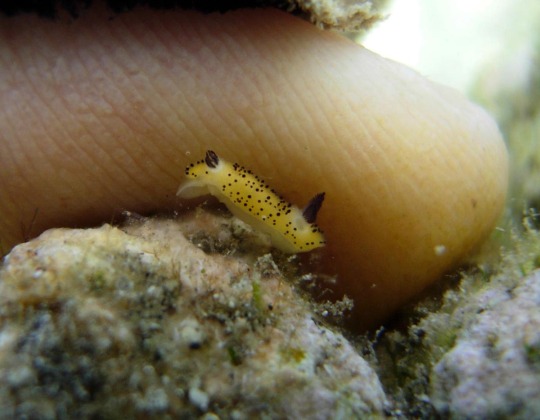
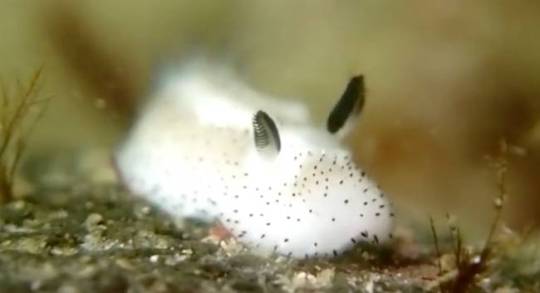
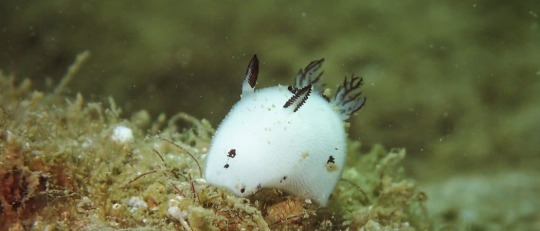
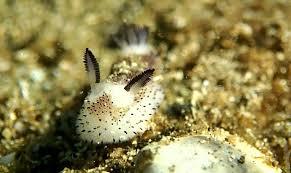
Sources: Wikipedia & National Geopgraphic
3 notes
·
View notes
Note
🌿🎀🍭
(for the fic writer asks, please)
Ooh, thank you, @curator-on-ao3 ! These are fabulous questions.
🌿 how does creating make you feel?
Like a deity who left the intern in charge for the day. Simultaneously all-powerful and completely clueless. I can make the characters do *anything*! Wait, I can make them do *anything*?
(But also, can I be honest? Over the last 6 months or so of grappling with my writing, the answer has mostly been - frustrated. It's been like scraping every single letter out of concrete with a plastic spoon. I know exactly what happened: my real-life job got very toxic, very suddenly, last year, and although I'm out of it now and in a job I really love, the damage done to my confidence is taking time to heal. Reading back over the last few chapters and my notes for the final two installments with a clearer head and the benefit of distance, I can *see* that loss of confidence on the page - I'm over-explaining, over-complicating, all the time, bouncing around ideas without committing fully to them. Now that I'm safely in a better place, I've been recharging my creative cells now and working on being gentler with myself, and the words - and the joy - are slowly starting to come back, but it's been a slog to even get to this point.)
🎀 give yourself a compliment about your own writing
Usually I'd shuffle and dodge this question by mumbling something about being good at creating characters who feel like individuals. While that's true, I think, as part of Operation Rediscover My Confidence and Love of Writing (note to self: needs a snappier name), I've been rereading my work and I now have a new answer! I think I'm good at taking risks. I wrote a detective fic in space - something I'd never tried before - in which the answer to the mystery the central character is trying to solve is one everyone reading will know because they've *watched the show*, and it *works*. And then I took that story and wrote a sequel in a completely different style, another one I'd never tried before, and wrote a spy thriller slow burn romance in space between two characters who will likely never, ever meet in canon, and it *works*. I write plotty fics with ice cream and terrible heists and wonky robots and secret societies and telepathic gastropods and, for some reason, Harry fucking Mudd, and it *works*. Not without a lot of effort, and not without a lot of drafts that will never see the light of day, but it works. So, yeah. I take risks. I write weird shit, and I love that about my writing.
🍭 why did you start writing?
Because sometimes, just sometimes, I had ideas that made my brain itchy. And the only way to scratch that itch was to pour them out on paper.
7 notes
·
View notes
Text
Our of the animals purchased for their use as biological control in reef aquariums, Mithraculus sculptus is one that has caused a great deal of worry to aquarists. This species is strongly algivorous, and is often purchased for the purpose of algal control. Subsequently the crab gets blamed for damaging corals, and even the deaths of fishes are attributed to the crab. Much confusion exists as to the riskiness versus 'reef safety' of this controversial species. To aquarists this species is known as the emerald crab or simply 'the' mithrax crab. Historically there was much debate about the distinction, or otherwise, of Mithraculus from its relative Mithrax.
Mithraculus is extremely similar to Mithrax, so close overall that observations about the general diet of one genus, also apply to the other. M. sculpta is also known as the green clinging crab in some literature Whatever we call it, this is a crab of the Caribbean and adjacent eastern Atlantic, from Florida and the Bahamas south to Brazil. It grows to about 4 centimeters, or about 1 and a 1/2 inches long.
Although ecological studies tend to stress the herbivory of Mithrax senso lato, both field and laboratory studies of these crabs in the 1970s, have demonstrated their omnivorous feedings, on macroalgae, cnidarians, and detritus. In an experiment, the captive Mithrax eagerly consumed pieces of fish and clam, as well as such marine animals as polychaetes, gastropods, and echinoderms. Mithrax consume Aiptasia anemones, so they are able to consume rather large polyps. The extent of their predation on fleshy polyps and colonies is not known.
Very motile animals such as fish, shrimp, and crabs, were consumed only by scavenging. Mithrax are clumsy foragers, certainly not hunters, and they do not detect prey well, merely consuming animal protein opportunistically. M. sculpta and similar crabs really are primarily herbivorous, although they preferentially take animal derived foodstuffs where they are available. In other words, they have evolved to exploit animal protein if it is encountered whilst feeding on algae. Mithrax crabs are able to extract live snails from their shells, but appear unable to crack hard shelled prey open.
In shallow seagrass beds, and the margins of reef flats, M. sculpta uses the branching, coralline macroalga Neogoniolithon strictum as a host, and the alga benefits from the effectiveness of M. sculpta at controlling epibionts. M. sculpta is also a facultative symbionts of Porites stony corals. The residence of M. sculpta among P. porites, reduces intrusive algal cover on the corals by more than 85%.
Such a statistic is proof of the efficiency of these craps. By day, these crabs shelter in crevices and beneath ledges. Although they are nocturnal, their algal diet restricts them to areas of sunshine. They avoid areas that are shaded during the day, which would impair the growth of their algal food. The claws of M. sculpta are spatulate, an evolutionary tendency among crabs deviating towards herbivorous lifestyles.
In the absence of appropriate algal growth, emerald crabs will consume such foods as nori. They will obviously accept defrosted meaty foods, and some dry preparations. But their natural diet, which is mostly herbivorous, ought to be replicated. Good reason exists to presume M. sculpta is a risk to slow, motile animals like gastropods and starfishes in the aquarium, as well as to large fleshy polyps. But they do not hunt fish, shrimp, or other crabs.
Aquarists should note there is some overlap between the macroalgal genera eaten by emerald crabs, and those purchased deliberately, for ornamental reasons. These crabs are also nocturnal by nature, and many aquarists never see theirs by day, sometimes fearing their pet crab is dead, only to discover the same animal alive, some period later. The species requires places to reside in the rockwork, where it will avoid bright light.
What is reef safety, anyway? A reef is a living ecosystem, and even those organisms that do not consume other organisms directly, are competing for sunlight or space. The idea of 'reef safety' implies a simplification of how organisms in an environment really interact, and is semantically meaningless. It is like saying an animal is 'forest safe' or 'prairie safe'. No one talks about any other biome, the way 'reefers' do about coral reefs.
#Mithrax sculpta#emerald crab#green clinging crab#mithrax crab#misunderstood crustaceans#crabs#algivores#herbivorous crabs#clean up crew
0 notes
Text
What Animal Eats Okra Plants?
Several animals and pests may feed on okra plants in gardens and agricultural settings. Common culprits include: Rabbits: Rabbits are known to munch on the leaves and tender shoots of okra plants. They can severely damage young plants. Deer: Deer are particularly fond of okra plants, especially in areas where deer populations are high. They can browse on both leaves and stems. Birds: Birds, such as sparrows and finches, may peck at okra fruits, particularly if they are mature and the seeds are exposed. Insects: Various insects can feed on different parts of okra plants. Common pests include aphids, caterpillars, stink bugs, and leafhoppers. These insects can damage leaves, flowers, and fruits. Squirrels: Squirrels may occasionally nibble on okra pods or damage plants while looking for a water source during hot and dry periods. Snails and Slugs: These gastropods can feed on the leaves of okra plants, creating irregular holes and damage. Rodents: Rodents like mice and rats may consume okra seeds or young seedlings. To protect your okra plants from these potential pests and animals, consider the following organic gardening strategies: Fencing: Install fencing around your garden or individual okra plants to deter larger animals like deer and rabbits. Netting or Row Covers: Use netting or row covers to shield plants from birds and larger insects. Be sure to remove covers for pollination if you have flowering okra plants. Companion Planting: Plant companion plants like marigolds, nasturtiums, and basil, which can help repel some insect pests. Beneficial Insects: Attract or introduce beneficial insects like ladybugs and parasitic wasps, which can help control aphids and other harmful insects. Organic Pest Control: Use organic pest control methods such as neem oil, insecticidal soaps, or diatomaceous earth to manage insect infestations. Traps: Employ humane traps for rodents like mice and rats if they become a significant issue. Regular Inspection: Regularly inspect your okra plants for signs of damage or pest presence. Early detection allows for prompt intervention. Remember that creating a diverse and balanced ecosystem in your garden can help control pests naturally. Additionally, maintaining healthy and robust okra plants through proper watering and nutrient management can make them more resilient to pest damage. Read the full article
0 notes
Text
Noise harming ocean invertebrates and ecosystems
Scientists reviewed hundreds of studies on the impact of noise on marine invertebrates (such as crabs, molluscs, squid, prawns and worms). They concluded that noise caused by humans is harming invertebrates in numerous ways, from cellular level to entire ecosystems. The international team, including Universitat Politècnica de Catalunya — BarcelonaTech (UPC) and the University of Exeter, call for urgent research to investigate and mitigate these impacts. “Many people are surprised to discover that invertebrates can even perceive sounds, but in fact sound is fundamental to their survival,” said first author Dr Marta Solé, from UPC. “Light doesn’t travel very well in water but sound does, and invertebrates use sound in a variety of ways. “Human activities — especially shipping — are changing the ocean soundscape rapidly, and our study brings together the latest evidence on the impacts of this.” The study highlights the multiple impacts of anthropogenic (human) noise on invertebrates: It can delay hatching and egg development in crustaceans, and significantly increase abnormalities and death rates among larvae of crustaceans, bivalves (eg mussels and oysters) and gastropods (eg snails). Low-frequency sounds can cause injuries and even death. For example, research has shown that sound from underwater explosions can kill blue crabs. After an increase of cephalopods (eg squid and octopus) washing up on beaches in Spain, research showed that noise had damaged their statocysts (hearing organs that help them navigate). Impacts on behaviour include many species displaying a “startle” reaction in response to loud sounds. Long-term exposure to noise also affects behaviour. For example, ship sounds limit the ability of shore crabs to change colour to camouflage themselves Physiological changes have also been discovered. For example, Mediterranean common cuttlefish showed changes in the protein content due sound exposure — with some of the affected proteins related to stress. In another study, permanent high-level exposure to sound caused a significant reduction in growth rate and reproduction, an increase in aggressiveness and mortality rate, and a reduction in feed intake of shrimp. By changing the behaviour and health of predators and prey in complex food webs, noise can affect entire ecosystems — and the researchers say more research is needed to investigate this. Recent studies have revealed that a wide range of invertebrates are sensitive to sounds, especially via sensory organs whose original function is to allow maintaining equilibrium in the water column and sensing gravity. Invertebrates can detect underwater sound through three types of sensory systems: “superficial” receptors on their body surface, internal “statocyst” receptors (equivalent of ears), and flexible “chordotonal” appendages that sense vibrations. They can also produce sounds — ranging from the “cough” of scallops to the creaks made by lobsters, crayfish, shrimps and crabs, possibly to ward off predators. “Our study underlines that these animals exist in a rich underwater soundscape,” said Dr Sophie Nedelec, from the University of Exeter. “We urgently need to know more about the impacts of noise pollution on these animals and ecosystems. “Considering that noise can affect invertebrates from cellular to ecosystems level, we need to bring together interdisciplinary expertise to embrace a holistic vision of the problem. “Given the many pressures being caused by humans — including from climate change and fisheries — we must do everything we can to limit underwater noise.” Ships and boats are the main sources of marine noise, but a wide range of other activities including drilling, dredging and sonar also cause noise. Seabed mining in international waters could be permitted for this first time later this year, and a recent study by Exeter researchers raised concerns about the noise impacts on wildlife.
0 notes
Text
Tumblr deleted my rant mid typing and I gotta restart
Nudibranchs are a type of marine gastropod which also places them in the wider group of gastropods. The name translates to "Naked Gill" referring to how their gills are outside their body. These are either bunched up into one spot like a tail (Dorids) or as cerata across the whole body (Aeolids). They additionally have rhinophores which are the ear like appendages they have. They are used to both smell and taste the chemicals in the water and are their primary method of sensory as their eyes can only detect light and darkness. One interesting aspect of a lot of nudibranchs is them stealing various tools of their prey, such as the Blue Sea Dragon which steals the venom from its prey (The Portuguese Man O War) to use as its own. They are also all intersex and their reproductive organs are located on the left side of their bodies close to their heads. Like all mollusks they also contain radula, which act as a combination between tongue and teeth that allows them to consume their prey. Some of the most notable species include the previously mentioned Blue Sea Dragon, but also Sea Bunnies and Thecacera pacifica which bares a resemblance to Pikachu. They're sometimes confused with species of Sacoglossa, another group of sea slugs, that are most notable for eating algae and gaining the ability to photosynthesize with them (The most notable species here is the leaf sheep). I love these funky littles guys and can go into more detail, but might as well start with the basics
Funfact I am autistic and everyday must fight to contain my nerdy ramblings. Because not everyone needs a 20 minute info dump about Nudibranchs no matter how badly I want to say it
29 notes
·
View notes
Text
°☆ | ARTBLOG | FAQ+PROJECTS °☆
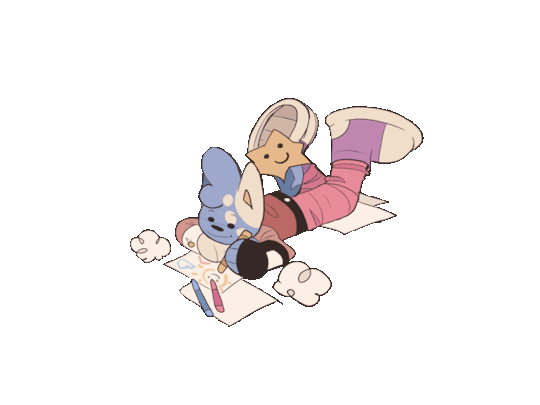
Learn about CALENDERTOWN !!!
Check out my PSYCHONAUTS MERCH ARCHIVE !!!


TAGS:
#ispy.png general art tag
#knicknacks OC / Original art
#Cluecrafts mixed media crafts and sewing projects I do!
#dustbunnies.txt Thoughts/ General chatter tag
#FAQ Frequently asked questions
#captainslog askbox
#DetectivePosting all my detective thoughts in one place!
#CreamOfTheCrop Not my art, but art i like! check it out!!
#comic.txt meta or text posts about comics!
#comicstag comic resources or reccomendations: my reading list!
#panels comic panels reblogs!
#Fave /fave.png my favorite images or posts!
i post bugs often! they will be tagged under #bugtag Please note: i include crustaceans, gastropods and various other beasts under this tag as a catchall!
35 notes
·
View notes
Photo

guess what! it’s some previews of the ebayfriends patreon bonus feed!
these are all from recent themes: birds, sleepytime, and gastropods.
see all these guys plus a whole bunch more for just $1/month! all the listings i post are hunted up from corners of the web and under 20 dollars from in the US, and you’ll get twice-monthly input as to what i go hunting for. i post 60+ friends in a month, and you can access all previous months when you join!
patreon members can also ask for toy detective service (trying to identify or find a listing for something specific) and i’ll make it part of my regular searches.*
there’s not a lot of folks on there, so your voice will have quite a bit of weight. in fact, right now a lot of the polls for what I should do next are tying! come check out the bonus feed at https://www.patreon.com/smallfriendsmonthly. if you join in the next couple of days you’ll be able to vote on what the first theme for september should be!
for $3/month, you can also get a little drawn buddy in the mail. like so:

*/r/HelpMeFind and Plush Memories Lost Toy Service on facebook are some other places you can go to look. I try to help out in those groups when I have the time!
82 notes
·
View notes
Photo

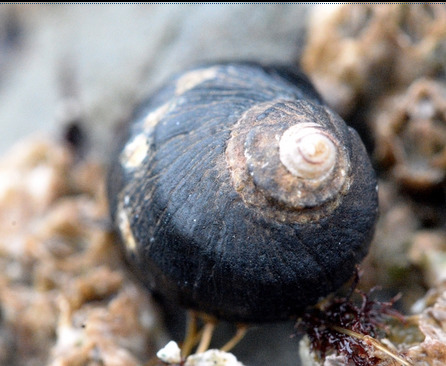
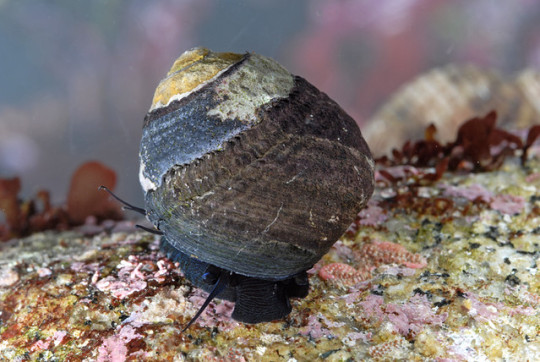
Superb Black Turban Snails
For beach-goers along the North American Pacific coast, the black turban snail (Tegula funebralis) is a common sight. They can be found from the northern reaches of British Columbia, Canada to southern California in the United States, almost exclusively in the intertidal zone. Although they are small, weighing only 20g and about 5 cm long, their clusters are hard to miss. Groups of hundreds of black turban snails congregate in seaweed beds, under rocks, and in the tight crevices of the rocky shoreline, and disperse only when they are covered by the sea.
The most distinctive feature of T. funebralis is the shell. It is typically black or purple, but over time the outer layer of chiten can wear away to reveal a pearly inside. These shells are sought after by people for decoration, and by hermit crabs for shelter, although in both cases the shell is typically scavenged after it has already been emptied by predators. The rest of the snail’s body is black, soft, and can curl easily inside its shell to protect itself. As a member of the order Trochida, these snails also have an ‘operculum’; a hard trap door- like structure that the snail can close the aperture of the shell with to further protect itself. Interestingly, turban snails also have a unique organ called a bursicle that can sense chemicals released by their predators; primarily sea stars and crabs. When a threat is detected, the snail may either curl up in its shell or attempt to flee at a racing 8cm per minute.
Like many gastropods, black turban snails are herbivorous. Their primary food is algae, especially macroscopic algae like seaweeds and kelp. They compete with other grazers, mainly hermit crabs and urchins, for this food, although it’s not uncommon to see all three in the same area. In turn, black turban snail shells are sometimes colonized by limpets and slipper snails, which feed on the red algae that grows there. Periwinkles or other predatory snails will also sometimes attach themselves to turban snail shells and predate upon them by boring holes through the shell itself, but this is less common.
The main driver behind the black turban snail’s abundance is its high reproductive rates. It is a broadcast spawner, meaning that when it is covered by water, both sexes of the snail will release hundreds of thousands of gametes into the water column . Within a day or two, many of these gametes will combine and become microscopic larvae, which then disperse, metamorphose into juvenile snails, and settle in less than three weeks. Juvenile turban snails are a favorite food of sea stars, crabs, and intertidal fish, but the sheer number of young ensures that most will survive.
Conservation status: Although black turban snails were and still are a source of food for humans, they are extremely common and are considered of least concern. Their primary threat is ocean acidification and warming temperatures, but they are in turn a much larger threat to intertidal zone community stability when their primary predator, the sea star, is removed and their population grows unchecked.
#black turban snail#Trochida#Tegulidae#sea snails#mollusks#gastrpods#invertebrates#marine fauna#marine invertebrates#intertidal fauna#intertidal invertebrates#shore fauna#shore invertebrates#north america#Pacific Ocean#coasts#coastal invertebrates
66 notes
·
View notes
Text
The Middle Glaciocene: 110 million years post-establishment
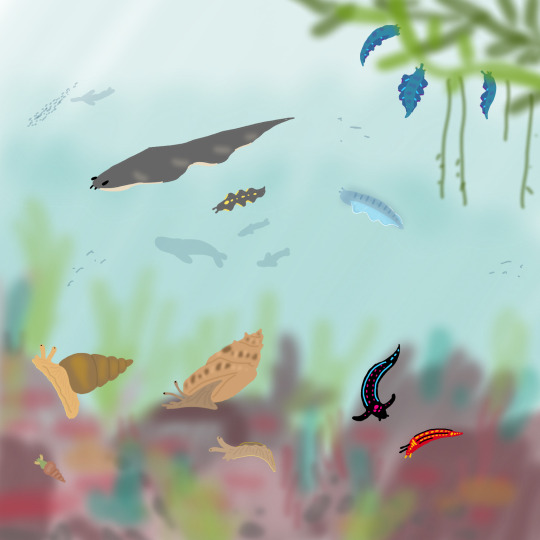
Tales of Snails: Marine Gastropods of the Middle Glaciocene
Since the beginning of the age of life at the start of the Early Rodentocene, the hamsters had dominated megafaunal niches on the planet as the ecosystem's sole vertebrate, while the shrish-- swimming crustaceans descended from krill-- have flourished in the oceans with the absence of piscine competitors into shoalers, filter-feeders, burrowers and shark-like predators. But for the past 110 million years another clade in the seas had been slowly but surely rising in prominence: the gastropods.
Descended from a few species of marine snails introduced into the waters of HP-02017, indeed, perhaps accidentally as a few dormant eggs that remained attached to the transplanted coral and algae during the planet's founding period, the colder, nutrient-rich waters of the Glaciocene has given this slowly-growing clade a chance to explode into a diversity unlike anything before. Now the gastropods are found in all of the seas and oceans worldwide, in a stunning variety of forms one would never have assumed from their humble ancestors.
Basal forms akin to conches and whelks are very abundant in the shallow-sea reefs, grazing on corals and algae and in turn being food for a wide range of aquatic fauna. Some lineages independently lost their shells, forming a polyphyletic group of "slugs", with one group, the slugworms, developing brilliant coloration and showy displays in a manner quite akin to Earth's nudibranchs. But more remarkable are another group of these shell-less "slugs" that, instead of creeping along on the sea floor, instead become active swimmers that propel themselves through the water with muscular contractions of a membranous fin-like extension of their foot- the pescopods.
Pescopods, in all their diversity, have avoided competition with the shrish with the help of a key gastropod feature: the rasping radula, or toothed tongue, that allow them to file away at tough food that the shrish are less-equipped to deal with. While most shrish are filter feeders, bottom sievers, or active predators, the pescopods gnaw away at floating vegetation, scavenge on sunken carrion, and feed on corals, sponges and hard-shelled bivalves with the help of their unique mouthpart allowing to rasp, scrape, drill and shave their way into a broad range of niches that are less pressured by the shrish.

Among the diversity of gastropods now colonizing the ocean are a diverse array of snails and slugs that, in the vacancy of many niches in the sea have twisted apart the basic gastropod body plan into forms better filling empty marine invertebrate niches. Shallowskimmers (family Ichthyocochlidae) are among the most widespread of the swimming slug-like forms, gathering near the surfaces of shallow tropical seas to feed on algae and water plants, and flourish in such numbers that certain species of marine predators such as shrarks and cricetaceans have specialized to specifically feed on them. Their bigger cousins, the ribbonslugs (family Lemniscochlidae) drift slowly across the open seas in enormously large numbers filtering out algae in a manner akin to the manta rays of Earth's oceans.
While some species of aquatic gastropods became highly active swimmers, other would become bottom feeders that are sessile, or at least nearly so. Quillnobs (family Pennacochlidae) are one such species: originating from a hard-shelled ancestor, these snails have evolved to fuse themselves to a single spot once mature, never to move again. Anchored to the spot by secreted cement derived from the mucous slime coat of most snails, they extend feathery extensions of their gills to trap drifting algae and zooplankton for nourishment. As they no longer move, they tend to cluster in large groups as to easily find a mate, and at times tend to overwhelm reefs and form entirely new biomes made entirely of these strange, barnacle-like creatures.
Some other bottom feeders would take on forms akin to echinoderms--a clade highly diverse in Earth's oceans, but absent here. The asterisks ( family Stellacochlidae) are one such clade of bottom-dwelling, soft-bodied "slugs" whose foot possesses strong muscular extensions that help them anchor themselves to hard objects on the sea floor or on food sources that they feed on. With small, vestigal eyes that can only detect light and dark, asterisks rely mostly on touch, smell and taste to navigate, feeding on whatever they can find at the ocean floor, including algae, sponges, corals and scavenging sunken carrion of shrish and marine hamsters such as seavers, though some asterisks are active predators of hard-shelled prey such as quillnobs, using a specialized radula to drill right into their shells.
But even basal forms can be downright bizarre in their own ways. Of the basal, unremarkable clade of shell-less slugs is one truly bizarre clade that seems almost like an example of evolution gone wrong: the hermit slugs (family Conchomutoridae). Hermit slugs have, over the years, lost their protective shells. But now they have returned to a lifestyle akin to a typical hard-shelled snail, except that instead of being born with a shell of their own, they instead borrow one. Shells of aforementioned whelk or conch-like species are particular favorites, but they are not especially picky: some use broken-off corals, shed shrish exoskeletons, and even the seed pods of coastal-growing cloverferns that end up in the water. And one genus, in its quest for house-hunting, turned to active predation in order to acquire both a house and an easy meal in one: the homewrecker (Casaklepta spp.) which hunts shelled gastropods, harpooning them with specialized neurotoxins, then gradually eats away all the soft tissues of their unlucky victim, leaving only an empty shell--which the homewrecker then moves right into.
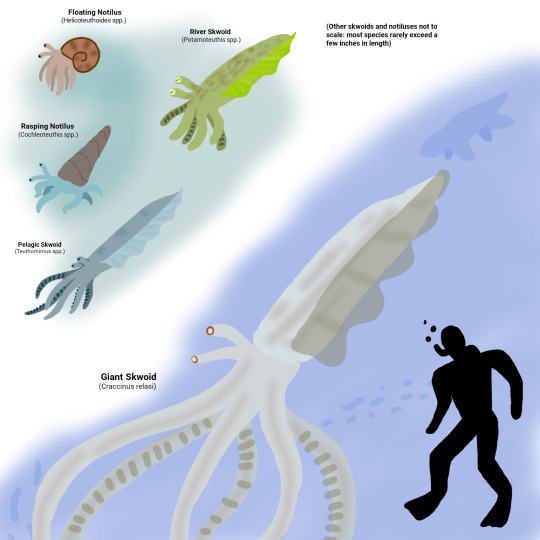
But without a doubt the most fascinating and derived of these marine snails are the notiluses (family Gastrocephalopoda), a group of basally-shelled gastropods that have developed six fleshy arms from the anterior portion of their foot, functioning like grasping arms that they use to move about and capture food. Some of the shelled forms are ammonite-like floaters that feed on small shrish and crustaceans, while others are bottom dwellers that use their arms to clamber about on the sea floor.
This lineage would eventually, during the Therocene, spawn a lineage of shell-less active swimmers with rippling foot-fins convergent with the pescopods-- the skwoids (subclade Cochleoteuthidae), which are even more convergent with Earth cephalopods such as octopi and cuttlefish. However, they are distinct in many ways: their eyes, surprisingly well-developed for a snail, are mounted on retractable stalks, their arms, which only have six instead of a cephalopod's eight or ten, are equipped with a single row of rectangular gripping pads as opposed to round suckers, and instead of a hooked beak, possess toothed radulas that are equipped with harpoon-like ends for spearing their prey.
Skwoids are exclusively carnivorous, feeding on shrish, crustaceans, and other snails such as pescopods, and are found in a wide array of aquatic environments. While most live in the sea, a few have ventured into freshwater, and have colonized rivers and streams as well, with freshwater skwoids typically being very small, measuring at most several inches and feeding on small shrish, aquatic insects, and on rare occasion small swimming pondrats as well. They are in turn prey for many other predators as well: and many species defend themselves by squirting a thick, gooey mucous that forms net-like ropy threads that entangle and confuse enemies and allow them to escape.
But in the deep, chilly regions of the southern Centralic Ocean, in the waters surrounding Peninsulaustra, there lives one species that dwarfs them all: the giant skwoid (Craccinus relasi). This deep-water species thrives on the abundance of massive swarms of aphotic-zone pescopods and shoals of shrish that gather at the nutrient-rich upwellings from the deep currents that are a breeding ground for plankton. In this near-abyssal region, relatively free of the air-breathing marine hamsters, the giant skwoid is free to grow to tremendous sizes, straddling the absolute upper limit for an invertebrate: a body length of up to four meters, coupled with six long arms extending up to an additional eight meters tops off its full length to a whopping twelve meters in the largest specimens, though smaller sizes of eight meters or less, with two-meter bodies, are far more common.
With its powerful arms, immense size, and harpoon-like radula, the giant skwoid is a force to be reckoned with: while generally a placid creature, it is a dangerous quarry for even the largest of the predatory shrish to tackle should it lash out when threatened, and for the majority of its existence during the Late Therocene and Early Glaciocene, the giant skwoid enjoyed a relatively safe existence. But as the cold seas of the Glaciocene favored ever-bigger marine hamsters, reaching sizes unlike anything before, the Middle Glaciocene will soon have the giant skwoid finally meet its match-- in the form of the largest marine predator, and largest hamster yet, to live on the planet of HP-02017.
▪▪▪▪▪▪▪▪▪
49 notes
·
View notes
Text
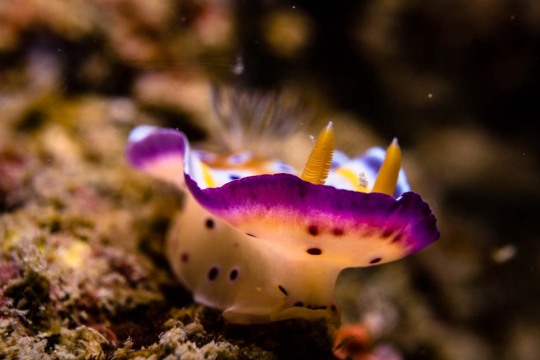
Marilyn Monroe Nudibranch
Picture of a Goniobranchus geminus
We are a Marine Life Conservation Organization. All income goes towards our Marine conservation and Protection Projects. To get more information please visit our Homepage.
Edition: 1/1 License: The primary NFT owner may use it in advertising, display privately and in groups, including virtual galleries, documentaries and essays as long as attribution is credited. The creator grants no rights to create commercial goods, commercial distribution or derivative works. The copyright remains with the creator Daniel Sasse.
The Marilyn Monroe under the Nudibranches. I guess you can see why?! ;) Some Species of nudibranchs show 'mantle-flapping' in which the whole of the mantle edge rises simultaneously and then falls simultaneously. At this stage we have no idea what the 'purpose' is, if any, for this type of behavior.
Did you know?
Nudibranchs are hermaphroditic, thus having a set of reproductive organs for both sexes, but they cannot fertilize themselves.
Goniobranchus geminus, also known as the gem sea slug, is a species of very colourful sea slug, a dorid nudibranch, a marine gastropod mollusc. It can reach a maximum size of 5cm.
G. geminus has large purple or purple-brown spots or marks, usually ringed with white, and often reticulate yellow background, and a purple border. Chromodoris geminus having four colour bands around the mantle edge, an outermost white, then translucent greyish purple, then white, then yellow.
Rescue the Ocean with your Purchase!
All income goes towards our Marine Life Conservation Projects!
You can now Donate in Cryptocurrency to support our Marine Life Conservation Projects.
To give you a brief idea of the diversity of our work, I would like to introduce you to a few of our environmental protection projects we have implemented,
We conduct Fish and invertebrate count and surveys, identifying and documentation of fish diversity, monitoring water quality changes, dissection of deceased fish for plastic detection in tissues and digestive organs.
I was able to achieve great success with our project of coral propagation (restoration and reconstruction of coral reefs). I have been an instructor for CP since 2014 and so over time 2000 new corals have been planted. For this I received an award from the organization “Ocean Quest” and “Sea Shepherd Dive”. Newly planted corals the size of a pinhead are monitored with underwater photography. Success rate of 93%.
Numerous implementations of underwater clean-up dives and their organization. Every month we collect over 500 kg of garbage from the sea floor. The future vision is to specifically recycle the plastic waste and use it to produce anchor buoys. To document this, both photos and videos are used.
Construction and setting of permanent anchor buoys so that boats no longer throw their own anchors into the reef and thereby destroy corals.
We train our volunteers to become scientific scuba divers, I teach marine biology, shark protection, coral propagation and underwater clean-up courses.
Our latest Project is our shark protection project. Due to habitat loss and bad media, we systematically educate the population, counting as well as taking pictures and videos are needed for the identification and to create Databases, to protect biodiversity.
Thank you very much and with your purchase you are protecting a piece of our fragile oceans!
#nudibranch#danielsasse#nature#oceandefender#savetheoceans#ouroceans#marinelifeprotection#saveourseas#ecowarrior#underwaterphotography#NFT#opensea#nft marketplace#nftsale
2 notes
·
View notes
Text
𝐒𝐞𝐚 𝐇𝐚𝐫𝐞? 𝐒𝐞𝐞 𝐇𝐞𝐫𝐞!
LET’S PLAY!
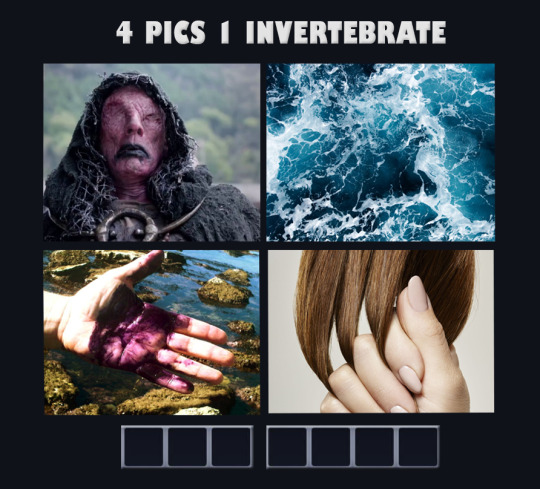
Get to know more about this invertebrate by reading this blog! It contains the classification, biology, relationship to humans, and interesting facts about this marvelous organism, specifically one of its subgroup — Aplysia.
CLASSIFICATION

Kingdom: Animalia
Subkingdom: Bilateria
Infrakingdom: Protostomia
Superphylum: Lophozoa
Phylum: Mollusca
Class: Gastropoda
Subclass: Opisthobranchia
Order: Anaspidea
Family: Aplysiidae
Genus: Aplysia
Species: Aplysia californica
(ITIS, n.d.)
Aplysia, commonly known as spotted sea hares, belongs to the group of gastropod molluscs. There are 37 known species in this genus. The word Aplysia came from the word L’Aplysia which means “that which one cannot wash”. They are one of the oldest mentioned animals from historical texts with the first authentic description provided by Pliny in his Historia Naturalis (published on 60 A.D) (Moroz, 2011) .
BIOLOGY
Ocean Globetrotters
These invertebrates are benthic dwellers that occupies the middle and lower intertidal zones, grazing on sea beds or corals. They are distributed in subtropical and tropical tide zones with one species (A. punctata) even reaching the Arctic Circle. Seven species of Aplysia can navigate long distances for example A. brasiliana which can travel up to 1 km in one swim episode (Moroz, 2011).
youtube
Spotted sea hares move in two ways, either by swimming or crawling on the sea bed. They swim by doing synchronized waves of muscular contraction pass from anterior to posterior to make a funnel that pulls in water, squeezing the anterior parts of the parapodia together forces the water out behind the creature and pushes it forward. While, they can crawl by raising the leading edge of the foot and extending it forward in an arching pattern so the rest of its body follows the arching pattern until it reaches the tail (Dice, 2014).
The Naked Alien
The body of spotted sea hares consists of a head, foot, and visceral mass. It is partially distorted, not coiled, and superficially bilaterally symmetrical (Fox, 2006).
The head has an anterior pair oral tentacles. The median union of the two tentacles forms a transverse oral veil over the mouth. A pair of rhinophores project dorsally from the surface of the neck. The oral tentacles and rhinophores serve as sensory organ. Specifically, their eyes are located at the base of each rhinophore (Fox, 2006).
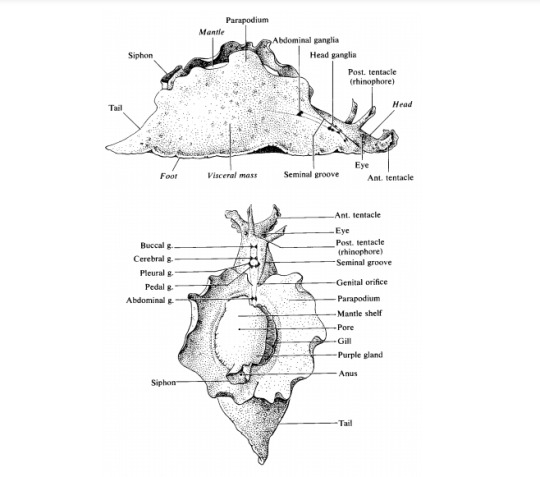
(Brooks & Hiller, 2001)
The foot lies along the midline of the ventral surface. Its posterior part serves as a sucker that is used to attach the posterior end of the animal while anterior end is elevated above the substratum. The foot extends posterior to the body as a short tail. Dorsolaterally, it is divided into two wing-like parapodia that is used for locomotion (Fox, 2006).

(Brooks & Hiller, 2001)
Their mantle and mantle cavity are found in the middle. The mantle is the dorsal body wall of the visceral mass. Inside it, the shell can be found. Below the shell is the reduced and small mantle cavity that opens broadly to the right containing the gill, anus, and gonopore. At the posterior right corner of the shell is a folded mantle resulting to a short, tubular, exhalant siphon that encloses the anus (Fox, 2006).
A Salad Lifestyle
youtube
Spotted sea hares feed on algae. A. californica (California sea hares) feeds on several kinds of red algae such as Laurencia pacifica, Plocamium pacificum and Ceramium spp. as well as sea lettuce and eelgrass. These organisms utilize their toothed radula to grasp the algae and store it briefly in the esophagus. Then, the food moves into the stomach fixed with pyramidal teeth to further crush the substances The food is blended in with different stomach-related digestive fluids to further breakdown the matter while the wastes are discharged out through the anus (Dice, 2014).
Dating on Another Level
Sea hares gather to mate. With the absence of dating apps, they find each other through tactile and chemical cues. They have photoreceptors that recognize fluctuations in the intensity of white light. Sadly, they find it hard to detect red wavelengths. To compensate, they respond more to chemical changes in seawater using the osphradium which detects dissolved chemicals in the water (Dice, 2014).
Loyalty, whomstve?
From a spiral cleavage to blastula, gastrula, trochophore and finally, the first larval stages — the development of their embryo happens inside the egg capsules. Newly hatch veligers swim upwards using their cilia and may take months drifting in the ocean while feeding on microscopic algae and bacteria until they detect cues that prompts them to settle to the alga which they will feed on. After this, they undergo rapid metamorphosis wherein they lose larval characteristics. They become juveniles that resemble miniature adults in all major features except reproductive organs (Moroz, 2011). California sea hares reach sexual maturity after about 120 days (Dice, 2014).
youtube
Sea hares are hermaphrodites, but they never self-fertilize by nature. Their copulation generally involves dozens. Every creature might be either getting or conveying sperm (or both) in respect of their present sex and position inside the chain (Dice, 2014).
Short Fruitful Years
Their life expectancy is normally short, most commonly survive for just a year. Many of them loose their life after reproduction. Amazingly, cool temperatures help delay reproduction; hence, cooler waters can fairly protract their life expectancy (Emore, 2002).
Hey, Leave Me Alone!
youtube
Distressed spotted sea hares secrete a purple ink which contains chemicals that disrupts the sensory function of opportunistic predators (Moroz, 2011). This chemical defense coupled with the distasteful algal toxins accumulated from their diet significantly creates a habitat where they can roam freely and has few natural predators (Emore, 2002).
RELATIONSHIP TO HUMANS
youtube
Sea hares are known to be highly valuable laboratory animals especially in the field of neurobiology, more specifically in studying memory and learning behaviors. The California Sea Hare (Aplysia californica) is an important neurobiological model and is used extensively in studies of behavior and psychology. They have the largest neurons in the animal kingdom making it feasible to identify the specific nerve cells responsible for certain mechanisms.
As for their ecosystem role, this herbivorous organism serves as keystone species in the intertidal ecosystem by affecting the density and abundance of its algal prey.
5 Interesting FYIs about SEA HARES
1. DUAL PURPOSE WINGS
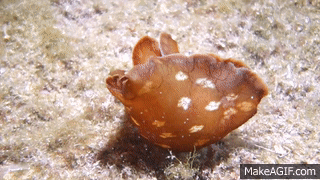
Sea hares have two large wing-like flaps that fold back on the body to protect their gills and internal shell plate. This wing-like extension is also used by some species of sea hares for short bursts of awkward swimming when threatened.
2. IT’S THE CIRCLE OF LIFE

As they say the more, the merrier. A circle of sea hares dubbed as a “Roman Circle” is formed during mating and copulation where each animal inseminates the one in front- a group sex indeed. As hermaphroditic organisms, sea hares serve as males at their front and females at their back.
3. GO AND MULTIPLY TO THE POWER OF 10
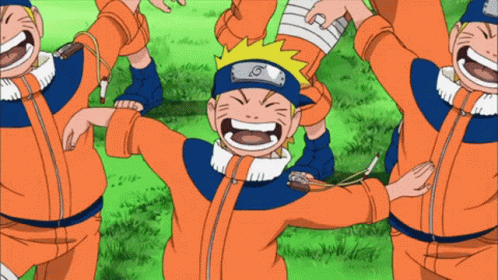
(Eleas, 2020)
Who cares about a twin, a quadruplet or a quintuplet? A single of this creature can lay up to 500 million eggs during one breeding season- that is more than a country’s population. Sea hares’ eggs are colored pink and often appear threaded.
4. WHAT YOU SEE, IS WHAT WE EAT
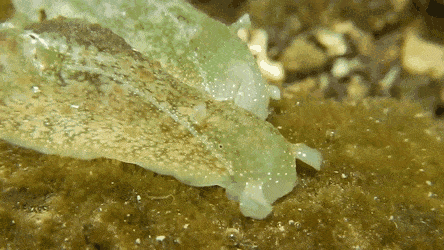
(Gfycat, 2019)
The color of sea hares are affected by the color of algae they consume. For example, young sea hares that tend to eat red algae are red in color, mature sea hares are colored green and brown because they consume algae that is also green and brown in color.
5. SEA HARES ARE CERTIFIED BTS STANS 💜 💜 💜
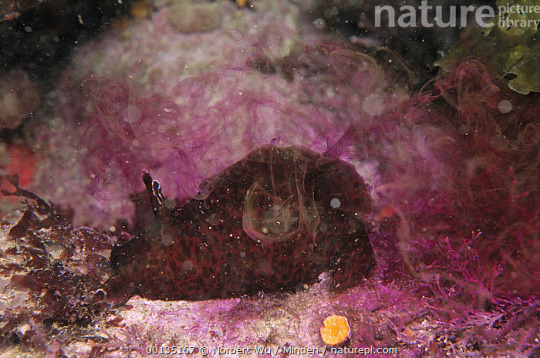
Sea hares have the right to use the infamous purple hearts on social media, and that’s a fact! This sea organism produces purple ink as a defense mechanism. Native Americans used this purple ink to dye clothing. Sea hares can also produce white or red ink depending on the color of the pigments in the seaweed they have consumed.

References
Angello, M. (n.d.). Full Frame Shot Of Sea Water [Photograph]. Getty Images. https://www.gettyimages.com/detail/photo/full-frame-shot-of-sea-water-royalty-free-image/730260985
Anonymous. (2017). Sea Hare Eggs [Photograph]. Ocean Safari Scuba. https://oceansafariscuba.com/photos/view_album/trip-11417-tidepool
Anonymous. (n.d.). Dinner Time with Sea Hares [GIF]. Gfycat. https://gfycat.com/unsteadydirectfreshwatereel-sea-hare
Brooks, R. & Hiller, J. (2001). The Role of Chemical Mechanisms in Neural Computation and Learning. [Photograph] .Research Gate. https://www.researchgate.net/publication/2524430_The_Role_of_Chemical_Mechanisms_in_Neural_Computation_and_Learning
Brown, C. (2010). Untitled [Photograph]. Flickr. https://inhabitat.com/wp-content/blogs.dir/1/files/2015/06/Sea-Hare-2-889x667.jpg
Dice, S. (2014). Aplysia californica. Animal Diversity Web. https://animaldiversity.org/accounts/Aplysia_californica/
Eleas. (2020). Naruto Clone GIF. Tenor. https://tenor.com/view/naruto-naruto-clone-funny-dancing-dance-gif-17857501
Emore, M. (2002). Aplysia dactylomela. Animal Diversity Web. https://animaldiversity.org/accounts/Aplysia_dactylomela/
Fox, R. (2006). Sea Hare. Lander University. http://lanwebs.lander.edu/faculty/rsfox/invertebrates/aplysia.html
ITIS. (n.d.). Aplysia californica J. G. Cooper, 1863. ITIS.gov. https://www.itis.gov/servlet/SingleRpt/SingleRpt?search_topic=TSN&search_value=78032#null
Moroz, L. (2011).Aplysia. NCBI. https://www.ncbi.nlm.nih.gov/pmc/articles/PMC4024469/
12 notes
·
View notes